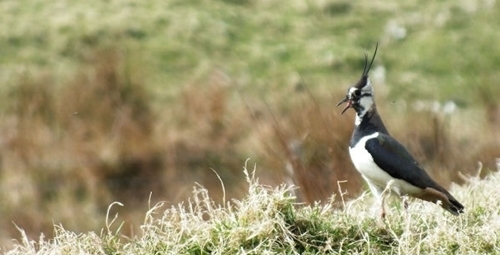Written by Simon Kibble, Working Conservationist

Whilst the winter of 2019/20 caused havoc to farming and life in general the spring wasn’t shaping up great either.
However difficult things are, there always comes a surprise to brighten the mood. In this case it was the arrival of two green plover (lapwings) or peewits as we refer to them. These birds hadn’t been seen on the farm for close on 10 years. Our farm comprises 220 acres, with cropping split 70% grass and 30% cereal crops.
The two birds settled in on a 20 acre field of winter barley stubble, which would not normally have been there but for the ground conditions not allowing for re-sowing, so it provided nicely for birds of all descriptions through the winter.
So with things looking up looking up we were blessed with the arrival of more birds on what seemed to be a daily basis; in total we had 12 making up six pairs. Five pairs set up on the stubble field and one pair on a small six acre winter wheat field in which there were some open areas. Their calls and displays were both a wonderful spectacle and music to my ears. Even into the early hours of darkness they would be calling.
With their arrival came a threat from the corvids, as is to be expected, but with our Larsen Trap and crow cages already running well, alongside control of foxes, rats, stoats and squirrels I pretty much had things under control, or so I thought.
What we hadn’t taken into account was the pressure that our two pairs of resident buzzards would bring to bear on this deceit of peewits[1]. Daily conflict ensued with no let-up but the peewits battled on, also seeing off occasional hassle from passing crows now the breeding pairs had been dealt with.
To try and alleviate the pressure we tried diversionary feeding the buzzards using the culled rats and squirrels along with the odd rabbit. Our initial finding was that this did reduce the amount of overflying done by the buzzards, but they still perched in outlying trees and moved about causing disruption and disturbance to the peewits.
As time progressed the stubble field was worked up in readiness for spring drilling. Sadly, during this work, despite my efforts to mark the nest sites, three nests were lost leaving two on this field and the pair who had set up on the open areas of the winter wheat. The loss of three nesting sites reduced the scale of the parent birds’ ‘flock response’ when defending their nests and chicks by half, which in turn brought about more pressure on those that remained.
So, for the peewits their daytime hours were spent in attempting to clutch eggs and incubate in between feeding and combating threats from above. Of course, that was only half the picture as they had to survive the nighttime hours as well, which involved more predation risks for the parents, eggs and chicks.
Included in nocturnal predators were badgers whose numbers on the farm have increased three-fold in six years. The hard ground conditions meant the badgers supply of earth worms was fast drying up, so ground nesting birds, eggs and chicks were more on the menu.
Such were my concerns over the badger numbers I contacted Natural England to see if I could apply for a licence to reduce said badger numbers .The discussion I had with the “agent” for want of a better word was most enlightening as he didn’t even know what a lapwing, green plover, peewit was until he had googled it. Initially he suggested nature should form the balance, but after asking, “what happens once we lose all our ground nesting birds due uncontrolled increasing badger predation?”, he suggested we use electric fencing to protect the plots.
So, it was to be, the situation was managed the best I could do short of being there all the time and making sure nothing occurred. As the days passed, it was evident that the pressure from the buzzards, passing crows and to a lesser degree jackdaws, not to mention badgers on the now open drilled barley field the two nests were lost, to what I’m unsure. This left our pair nesting in the winter wheat field who I didn’t hold out much hope as the flock response was no more, just the two birds trying to succeed in rearing a brood.
I had given up hope as the breeding pair hadn’t been seen or heard for a couple of days when to my amazement I spotted a bumble bee sized chick moving about on the open earth section. As I gazed through my binoculars, another appeared and then a third. Absolutely wonderful, I was over the moon, and watched them for a good five minutes thinking there could be a fourth. Sadly, it was not to be.
So, three chicks it was. What an effort it had been for these birds. What next lay ahead for this brood? Sadly, there is no more to tell as that was the last I saw of them; the parent birds left two days later. What had taken them or how they died I do not know. I’d done all I could and they hadn’t survived.
The work the GWCT does to highlight the situation with regards to predation loss and conservation measures is vital in influencing policy-makers to create policy that can help save the day.
[1] A group of lapwings is called a 'deceit' – named after the way the parent birds lure predators away from their nests by feigning a broken wing